
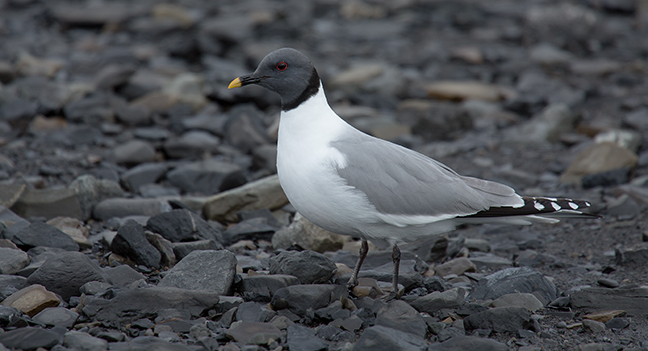
Sabine’s gulls are one of the rarest breeding birds in Svalbard. They nest in tundra areas where fresh water is available not too far from the sea. Outside the breeding season they are pelagic. They winter in oceanic waters of the Southern Hemisphere along the southwest coast of South America and off southwest Africa. (1/3)
©Rich Beckman

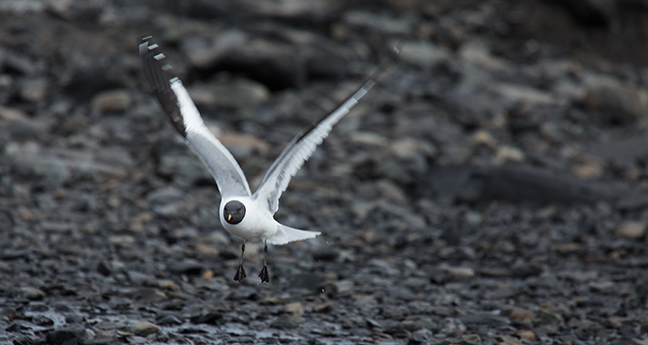
Sabine’s gulls are one of the rarest breeding birds in Svalbard. They nest in tundra areas where fresh water is available not too far from the sea. Outside the breeding season they are pelagic. They winter in oceanic waters of the Southern Hemisphere along the southwest coast of South America and off southwest Africa. (2/3)
©Rich Beckman

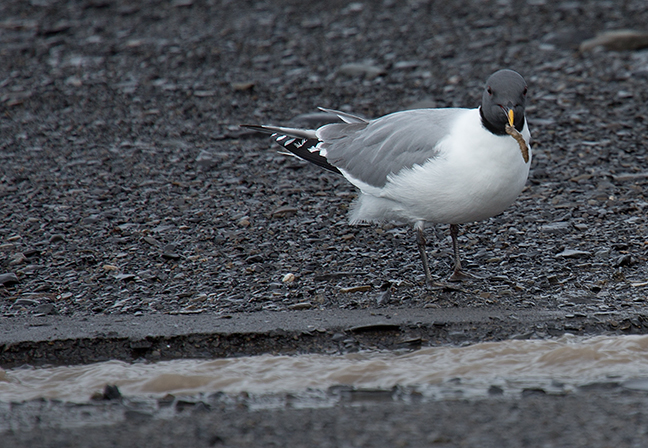
Sabine’s gulls are one of the rarest breeding birds in Svalbard. They nest in tundra areas where fresh water is available not too far from the sea. Outside the breeding season they pelagic. They winter in oceanic waters of the Southern Hemisphere along the southwest coast of South America and off southwest Africa. (3/3)
©Rich Beckman


The Arctic Tern is the only tern that breeds in Spitsbergen. They are common along the coast of most of Svalbard, and found in greatest numbers on the western and northern parts of Spitsbergen. They are often seen diving down onto the water surface to catch small fish, crustaceans or insects. It is the northernmost breeding tern species and the bird with the longest annual migration route. The breeding sites in the north and the wintering sites as far south as coastal Antarctica are up to 9,300 miles apart. (1/3)
©Rich Beckman

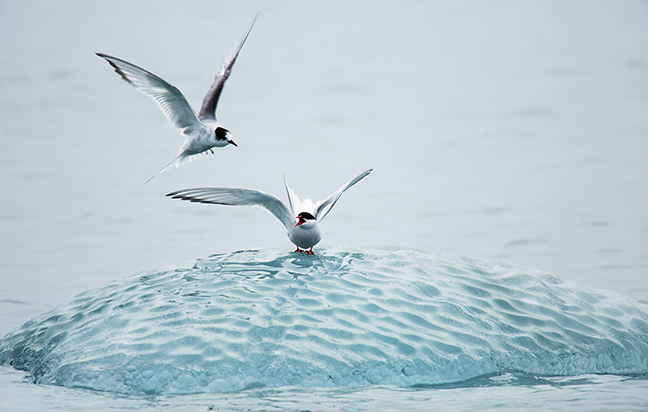
The Arctic Tern is the only tern that breeds in Spitsbergen. They are common along the coast of most of Svalbard, and found in greatest numbers on the western and northern parts of Spitsbergen. They are often seen diving down onto the water surface to catch small fish, crustaceans or insects. It is the northernmost breeding tern species and the bird with the longest annual migration route. The breeding sites in the north and the wintering sites as far south as coastal Antarctica are up to 9,300 miles apart. (2/3)
©Rich Beckman

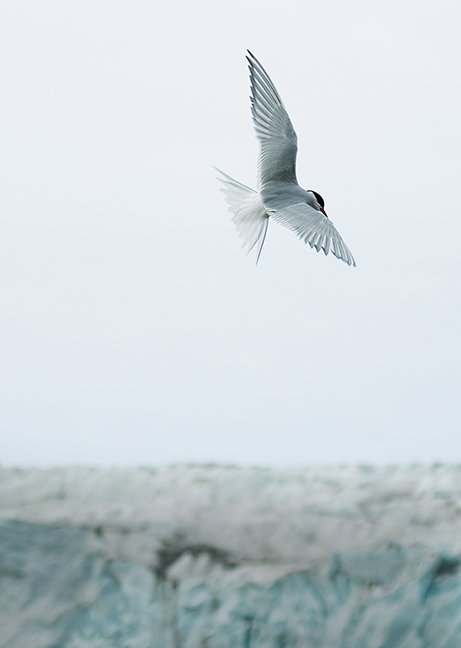
The Arctic Tern is the only tern that breeds in Spitsbergen. They are common along the coast of most of Svalbard, and found in greatest numbers on the western and northern parts of Spitsbergen. They are often seen diving down onto the water surface to catch small fish, crustaceans or insects. It is the northernmost breeding tern species and the bird with the longest annual migration route. (3/3)
©Rich Beckman

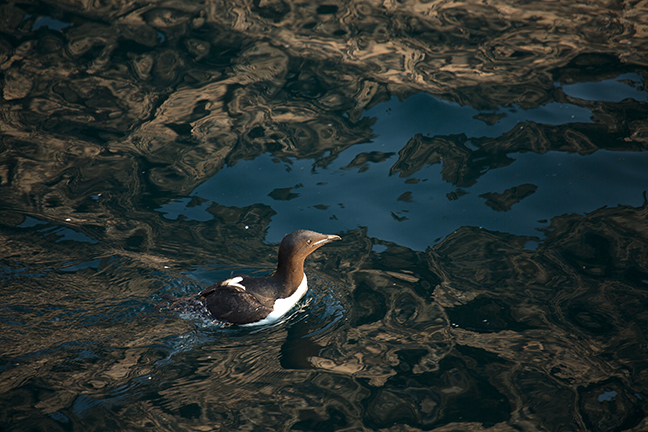
The Brünnich’s Guillemot (Thick-billed Murre) is a large black and white auk. It is distinguishable from the common guillemot by its shorter, thicker bill, which has a white line along the sides of the upper mandible. Several hundred thousand birds nest on the steep dolerite cliffs of Cape Fanshawe, near the northern end of Spitsbergen island. They do not build nests, but lay a single egg directly on a narrow cliff ledge. Eggs and chicks are susceptible to predation from Arctic Foxes and Glaucous Gulls. (1/7)
©Rich Beckman

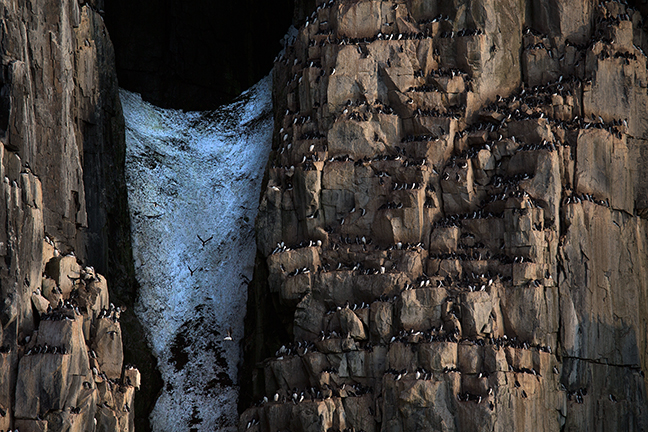
The Brünnich’s Guillemot (Thick-billed Murre) is a large black and white auk. It is distinguishable from the common guillemot by its shorter, thicker bill, which has a white line along the sides of the upper mandible. Several hundred thousand birds nest on the steep dolerite cliffs of Cape Fanshawe, near the northern end of Spitsbergen island. They do not build nests, but lay a single egg directly on a narrow cliff ledge. Eggs and chicks are susceptible to predation from Arctic Foxes and Glaucous Gulls. (2/7)
©Rich Beckman


The Brünnich’s Guillemot (Thick-billed Murre) is a large black and white auk. It is distinguishable from the common guillemot by its shorter, thicker bill, which has a white line along the sides of the upper mandible. Several hundred thousand birds nest on the steep dolerite cliffs of Cape Fanshawe, near the northern end of Spitsbergen island. They do not build nests, but lay a single egg directly on a narrow cliff ledge. Eggs and chicks are susceptible to predation from Arctic Foxes and Glaucous Gulls. (3/7)
©Rich Beckman

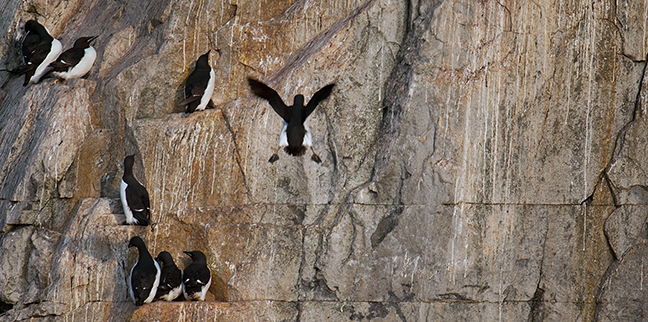
The Brünnich’s Guillemot (Thick-billed Murre) is a large black and white auk. It is distinguishable from the common guillemot by its shorter, thicker bill, which has a white line along the sides of the upper mandible. Several hundred thousand birds nest on the steep dolerite cliffs of Cape Fanshawe, near the northern end of Spitsbergen island. They do not build nests, but lay a single egg directly on a narrow cliff ledge. Eggs and chicks are susceptible to predation from Arctic Foxes and Glaucous Gulls. (4/7)
©Rich Beckman

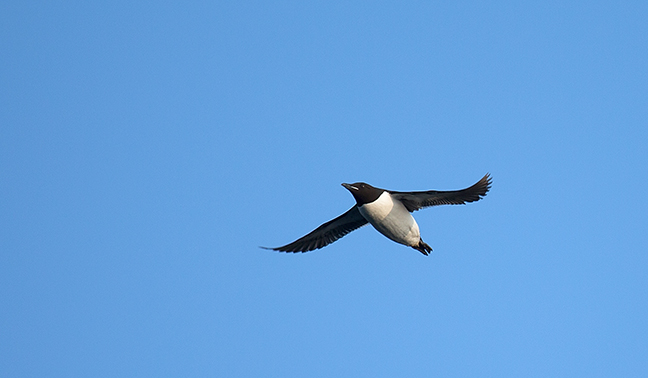
The Brünnich’s Guillemot (Thick-billed Murre) is a large black and white auk. It is distinguishable from the common guillemot by its shorter, thicker bill, which has a white line along the sides of the upper mandible. Several hundred thousand birds nest on the steep dolerite cliffs of Cape Fanshawe, near the northern end of Spitsbergen island. They do not build nests, but lay a single egg directly on a narrow cliff ledge. Eggs and chicks are susceptible to predation from Arctic Foxes and Glaucous Gulls. (5/7)
©Rich Beckman

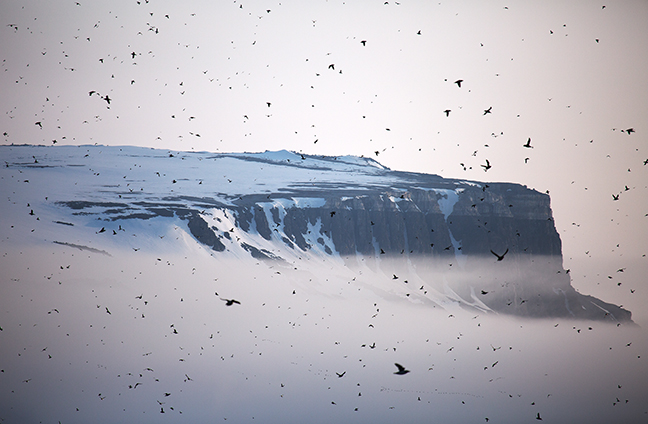
The Brünnich’s Guillemot (Thick-billed Murre) is a large black and white auk. It is distinguishable from the common guillemot by its shorter, thicker bill, which has a white line along the sides of the upper mandible. Several hundred thousand birds nest on the steep dolerite cliffs of Cape Fanshawe, near the northern end of Spitsbergen island. They do not build nests, but lay a single egg directly on a narrow cliff ledge. Eggs and chicks are susceptible to predation from Arctic Foxes and Glaucous Gulls. (6/7)
©Rich Beckman

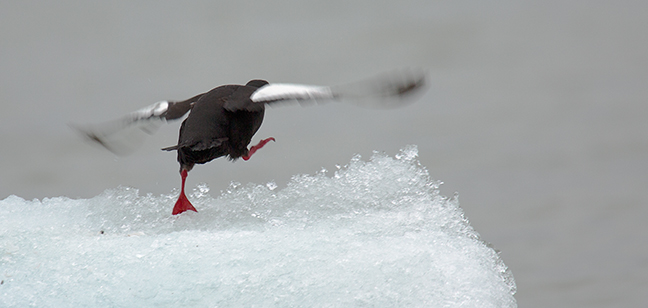
The Brünnich’s Guillemot (Thick-billed Murre) is a large black and white auk. It is distinguishable from the common guillemot by its shorter, thicker bill, which has a white line along the sides of the upper mandible. Several hundred thousand birds nest on the steep dolerite cliffs of Cape Fanshawe, near the northern end of Spitsbergen island. They do not build nests, but lay a single egg directly on a narrow cliff ledge. Eggs and chicks are susceptible to predation from Arctic Foxes and Glaucous Gulls. (7/7)
©Rich Beckman

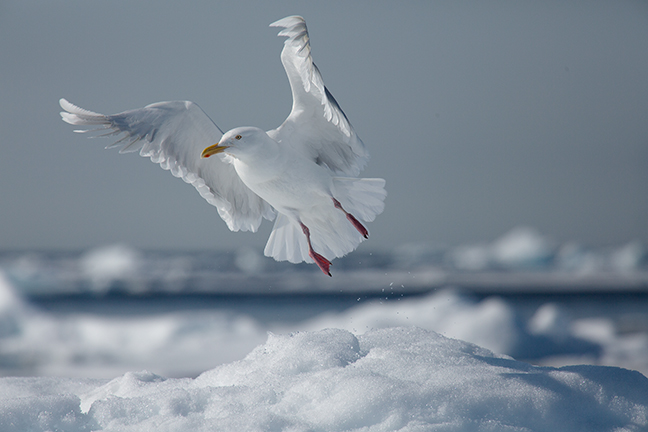
The Glaucous Gull is one of the largest gulls breeding in the Arctic and the only dedicated avian predator in Svalbard. It has a circumpolar, high arctic, breeding distribution and at least 1,000 pairs breed on Bjørnøya, the largest colony in Svalbard. They often breed in or close to bird colonies and specialize in preying upon eggs, chicks and adult birds of other seabird species. They eat fish, mussels, crustaceans, eggs, chicks and even adult Kittiwakes, Brünich’s Guillemots and Little Auks.
©Rich Beckman

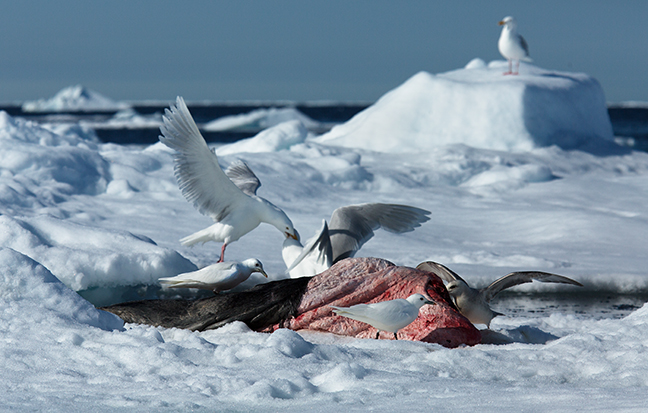
In Svalbard, the Ivory Gull breeds in small numbers on Spitsbergen, Kong Karls Land and Nordaustlandet, with the largest numbers occurring in the northern and eastern areas. It is a common species in ice-filled waters around the archipelago at all times of the year. They forage mostly within drift ice areas and at glacier fronts, but also fish and scavenge marine mammals killed by large predators. The breeding population in Svalbard is estimated to be between 1,000 and 2,000 pairs, although worldwide populations are threatened by decreasing pack ice cover and environmental toxins. (1/4)
©Rich Beckman

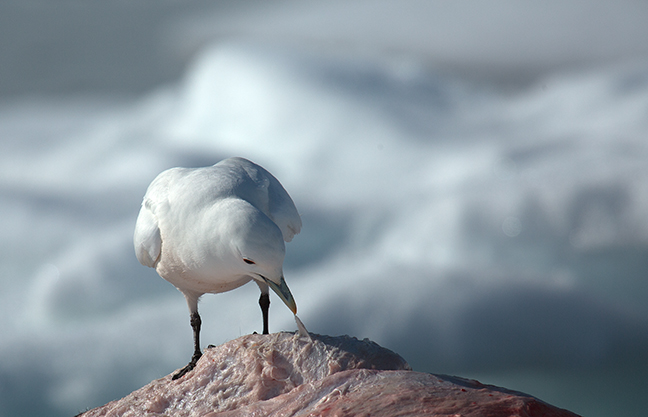
In Svalbard, the Ivory Gull breeds in small numbers on Spitsbergen, Kong Karls Land and Nordaustlandet, with the largest numbers occurring in the northern and eastern areas. It is a common species in ice-filled waters around the archipelago at all times of the year. They forage mostly within drift ice areas and at glacier fronts, but also fish and scavenge marine mammals killed by large predators. The breeding population in Svalbard is estimated to be between 1,000 and 2,000 pairs, although worldwide populations are threatened by decreasing pack ice cover and environmental toxins. (2/4)
©Rich Beckman

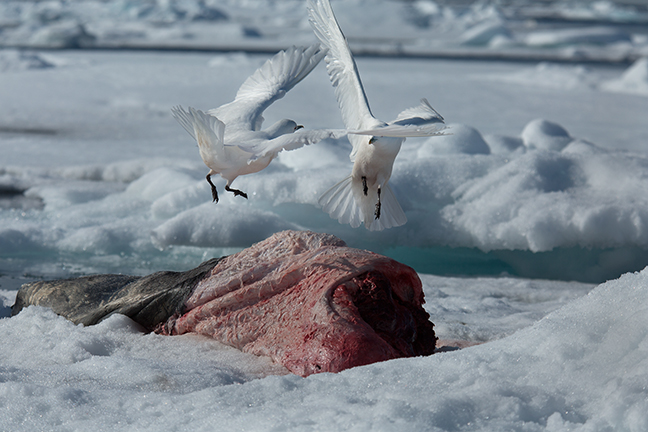
In Svalbard, the Ivory Gull breeds in small numbers on Spitsbergen, Kong Karls Land and Nordaustlandet, with the largest numbers occurring in the northern and eastern areas. It is a common species in ice-filled waters around the archipelago at all times of the year. They forage mostly within drift ice areas and at glacier fronts, but also fish and scavenge marine mammals killed by large predators. The breeding population in Svalbard is estimated to be between 1,000 and 2,000 pairs, although worldwide populations are threatened by decreasing pack ice cover and environmental toxins. (3/4)
©Rich Beckman

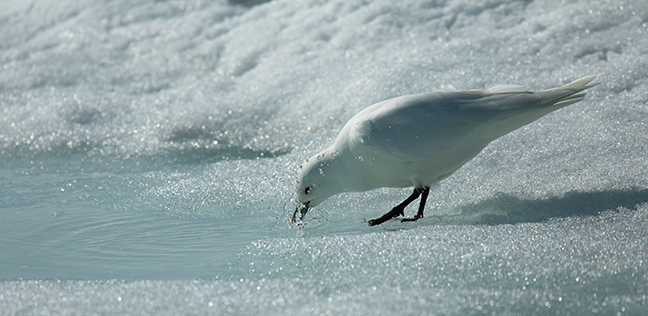
In Svalbard, the Ivory Gull breeds in small numbers on Spitsbergen, Kong Karls Land and Nordaustlandet, with the largest numbers occurring in the northern and eastern areas. It is a common species in ice-filled waters around the archipelago at all times of the year. They forage mostly within drift ice areas and at glacier fronts, but also fish and scavenge marine mammals killed by large predators. The breeding population in Svalbard is estimated to be between 1,000 and 2,000 pairs, although worldwide populations are threatened by decreasing pack ice cover and environmental toxins. (4/4)
©Rich Beckman


Black-legged Kittiwakes are common everywhere in the Arctic and sub-Arctic. In Svalbard, there are dense colonies on steep rocky cliffs throughout the archipelago, the largest being on Hopen and Bjørnøya. About 215 colonies are known in Svalbard. The Black-legged Kittiwake is the most numerous species of gull in the world. The species has a circumpolar distribution, breeding in the Arctic and boreal zone throughout much of the Northern Hemisphere. (1/3)
©Rich Beckman

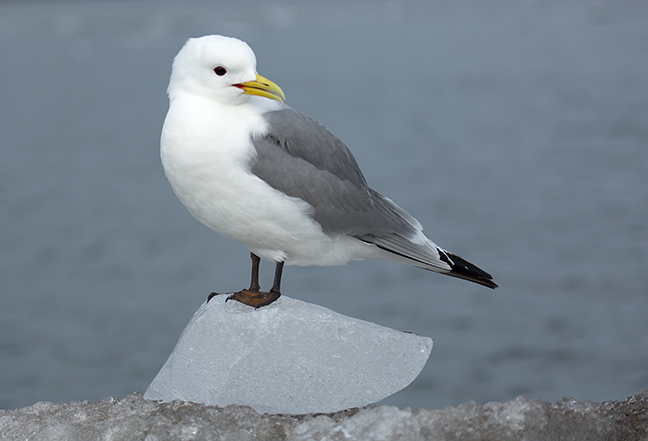
Black-legged Kittiwakes are common everywhere in the Arctic and sub-Arctic. In Svalbard, there are dense colonies on steep rocky cliffs throughout the archipelago, the largest being on Hopen and Bjørnøya. About 215 colonies are known in Svalbard. The Black-legged Kittiwake is the most numerous species of gull in the world. The species has a circumpolar distribution, breeding in the Arctic and boreal zone throughout much of the Northern Hemisphere. (2/3)
©Rich Beckman

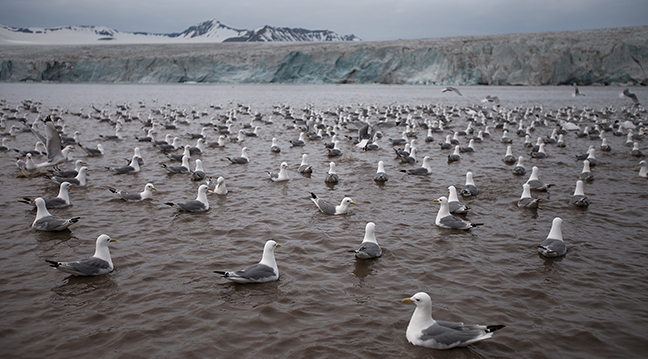
Black-legged Kittiwakes are common everywhere in the Arctic and sub-Arctic. In Svalbard, there are dense colonies on steep rocky cliffs throughout the archipelago, the largest being on Hopen and Bjørnøya. About 215 colonies are known in Svalbard. The Black-legged Kittiwake is the most numerous species of gull in the world. The species has a circumpolar distribution, breeding in the Arctic and boreal zone throughout much of the Northern Hemisphere. (3/3)
©Rich Beckman